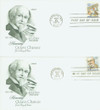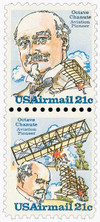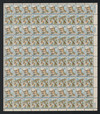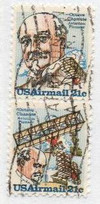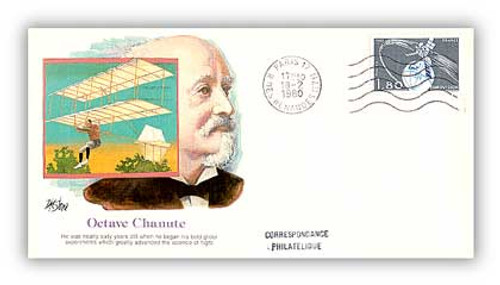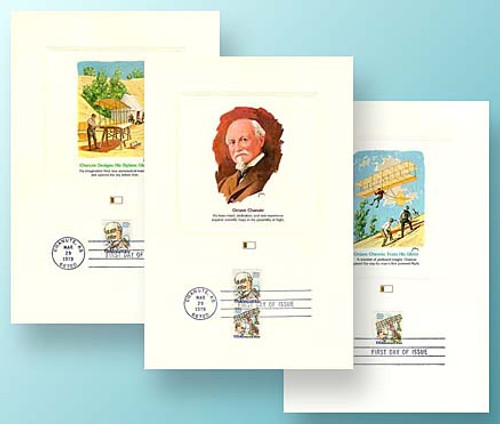
# C93-94 - 1979 21c Octave Chanute Se-tens 2V
Â
1979 Octave Chanute Issue
First City:Â Chanute, Kansas
Quantity Issued: Â unknown
Printed by: Bureau of Engraving and Printing
Printing Method: Lithographed, engraved (Giori)
Perforation:Â 11
Pioneers of Aviation Series
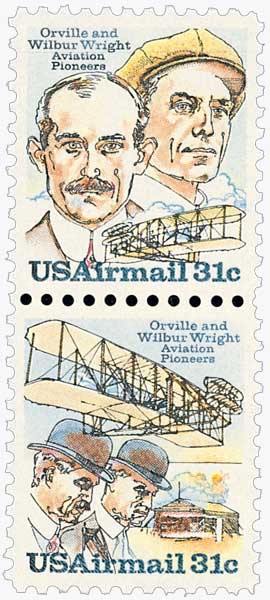
On September 23, 1978, the USPS issued the first stamps in its Pioneers of Aviation Series. The series would span more than 20 years and include 18 stamps honoring some of America’s most legendary aviators and their aircraft.
The stamps in the series covered the international airmail rate. The first few stamps maintained a similar size and style, but that would change over the course of the series. All the stamps featured the aviator and the plane with which they were most closely associated. And most included phrases such as “Aviation Pioneer†or “Pioneer Pilot.â€
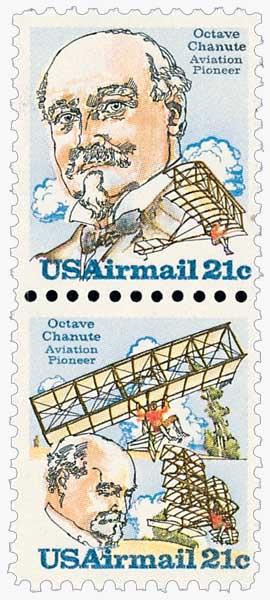
The first two stamps in the series were issued on September 23, 1978, in Dayton, Ohio. They commemorated the 75th anniversary of Orville and Wilbur Wright’s historic first powered flight in 1903. On the Wright Brother’s first successful airplane flight, the plane and pilot weighed 750 pounds. The wings were wooden frames strung together with piano wire and spanned forty feet, six inches. Orville piloted the twelve horsepower, four-cylinder gasoline engine biplane on the first attempt – staying aloft twelve seconds and traveling 120 feet. But at noon on the same day, brother Wilbur set the day’s record by flying 852 feet in 59 seconds.
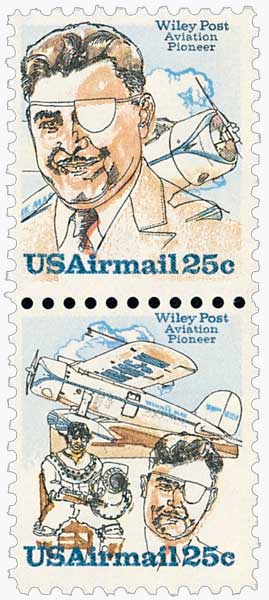
The second issue in the series, issued on March 29, 1979, in Chanute, Kansas, honored Octave Chanute. A civil engineer and aviation pioneer, Chanute’s major contribution to aviation occurred in 1896, when he designed his hang-glider. It became a standard for future glider design.
The third se-tenant in the series was issued on November 20, 1979, Oklahoma City, Oklahoma. These stamps honored Wiley Post, who is remembered as the first man to complete a solo flight around the world. He made his famous journey in his small plane, the Winnie Mae.
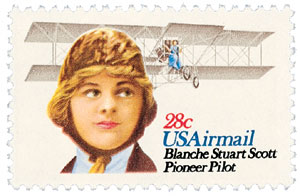
On December 30, 1980, the Blanche Stuart Scott stamp was issued in Hammondsport, New York. One larger stamp was issued, breaking with the format of the previous issues. Scott was the first American woman to fly solo. After her early flights, she joined a group of pilots on the daredevil circuit and earned the title “The Tomboy of the Air.â€Â Scott eventually became a special consultant for the United States Air Force.
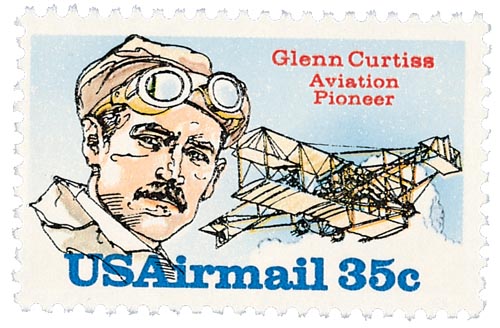
The Glenn Curtiss was issued on the same day and in the same city as the Blanche Scott stamp. Curtiss built his first airplane engine in 1907. After demonstrating that planes can land and take off from ships, Curtiss began making planes for the US Navy. He manufactured thousands of planes during World War I. In 1919, a Navy-Curtiss flying boat became the first plane to cross the Atlantic Ocean.
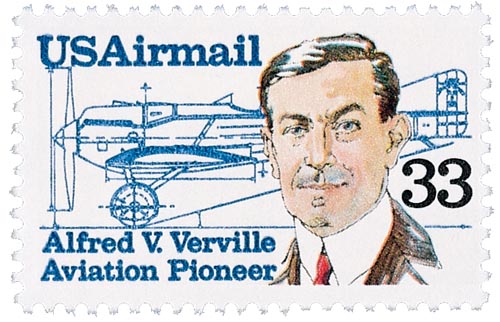
The next stamp honoring Alfred Verville was issued on February 13, 1985, in Garden City, New York. Verville helped Glenn Curtiss design the famed Curtiss Jenny and the Curtiss twin-engine seaplane. In the early 1920s, Verville and Lawrence Sperry designed and produced three aircraft. The most famous was the Verville-Sperry Classic Trophy in 1924, which could fly at a record of 216 miles per hour. Nearly a half century later, that plane was recognized by a panel of experts as one of the 12 most significant aircraft of all time.
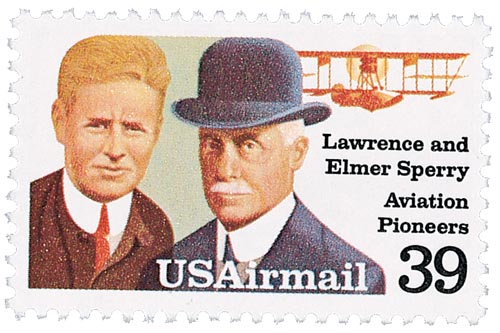
The next stamp, honoring Lawrence and Elmer Sperry was issued on the same date and in the same city as the Verville stamp. Elmer was awarded more than 400 patents. He revolutionized flying with such devices as the gyro compass and speed-direction indicators. Lawrence helped to develop and test such aviation innovations as the automatic pilot, retractable landing gear, and the first guided missile in the form of an aerial torpedo.
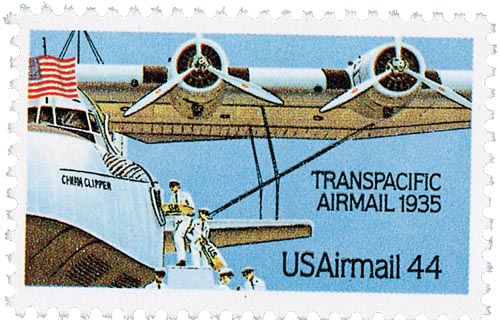
The next stamp in the series differed from the rest in that it didn’t picture an aviator. Issued on February 15, 1985, in San Francisco, California, it commemorated the 50-year anniversary of the China Clipper’s first trans-Pacific airmail flight in 1935. At that time, seaplanes had a non-stop range of less than 800 miles. Remarkably, every leg of the pioneer journey was completed on schedule. The China Clipper ultimately flew 3 million miles during a ten-year career.
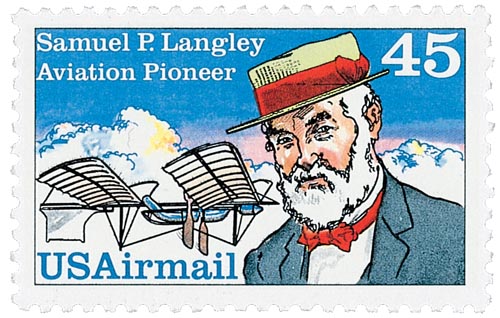
Next in the series came the Samuel P. Langley stamp, issued on May 14, 1988, in San Diego, California. Langley is pictured on the stamp with his Aerodrome No. 5. In 1896, he used a catapult to launch the unpiloted craft a distance of 3,300 feet.
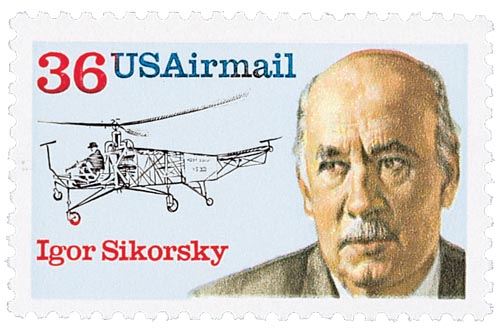
On June 23, 1988, the Igor Sikorsky stamp was issued in Stratford, Connecticut. Sikorsky was a native of Czarist Russia and a leading aircraft designer. Driven out of Russia by the Revolution, he became an American citizen and built the first practical single-rotor helicopter. The craft pictured on the stamp was successfully flown in 1940.
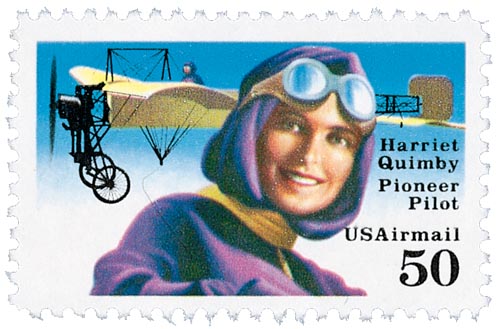
One of the few women honored on an airmail stamp, Harriet Quimby joined the series on April 27, 1991, with a stamp issued in Plymouth, Michigan. A journalist and drama critic, she was the first American woman to receive a pilot’s license, and the first woman to fly the English Channel solo.

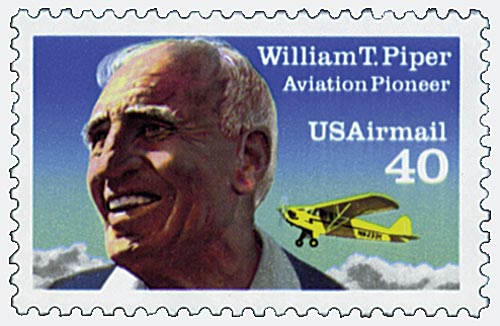
William Piper joined the series on May 17, 1991, with a stamp issued in Denver, Colorado. Piper was the designer of the popular Piper Cub plane, and called the “Henry Ford of aviation†for developing and promoting low-cost aircraft. His planes were also widely used during World War II – four out of five American pilots had been trained on Piper Cubs. The Piper stamp was reissued in 1993 with differences in the perforations, gum, paper, and other markings.
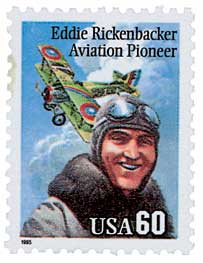
A major change occurred with the issue of the Eddie Rickenbacker stamp on September 25, 1995, in Columbus, Ohio. Up to this point, all stamps in the series had been airmails. According to the USPS, “With the introduction of the new international rates, the last distinction between airmail and surface mail disappears. All letters, packages, postcards and postal cards will now receive air service.â€Â  Interestingly, this was a policy Rickenbacker had campaigned for since the 1940s. Rickenbacker was the leading ace of World War I, shooting down a total of 22 planes and four balloons. Rickenbacker received a record eight Distinguished Service Crosses and years later was awarded the Congressional Medal of Honor.
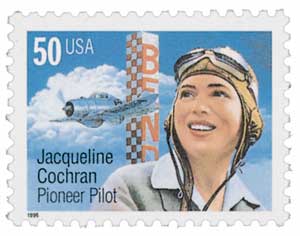
The Jacqueline Cochran stamp was issued on March 9, 1996, in Indio, California. At the time of her death in 1980, Cochran held more speed, altitude, and distance records than any other pilot, male or female, in the world. The first woman to fly faster than the speed of sound, she also founded the Women’s Air Force Service Pilots (WASP) program during World War II, and was the recipient of the Distinguished Service Medal and the Distinguished Flying Cross.
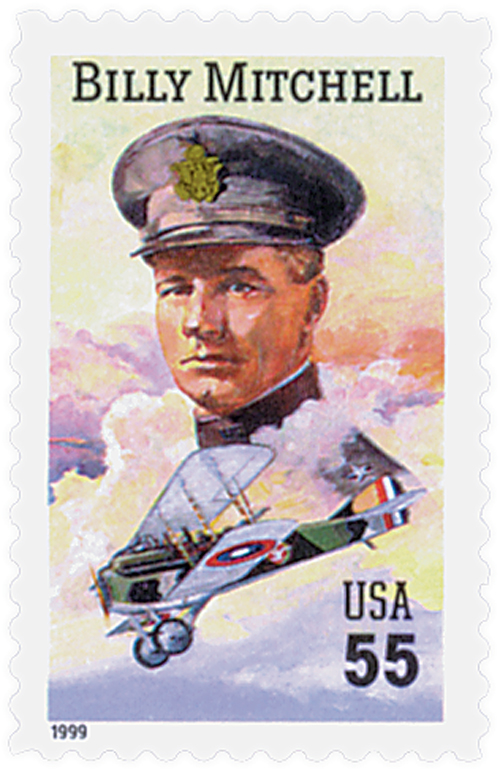
The final stamp in the series, honoring Billy Mitchell, was issued on July 30, 1999, in Milwaukee, Wisconsin. Mitchell is considered the father of the US Army Air Force, the aviation branch of the US Army that became the US Air Force in 1946. The stamp also pictures Mitchell’s personal SPAD XVI biplane.
Find lots more aviation stamps here.
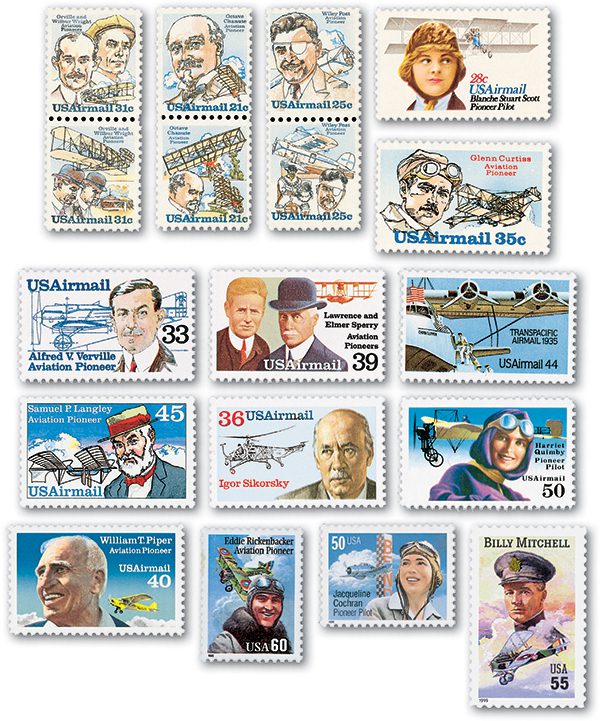
Â
Â
1979 Octave Chanute Issue
First City:Â Chanute, Kansas
Quantity Issued: Â unknown
Printed by: Bureau of Engraving and Printing
Printing Method: Lithographed, engraved (Giori)
Perforation:Â 11
Pioneers of Aviation Series

On September 23, 1978, the USPS issued the first stamps in its Pioneers of Aviation Series. The series would span more than 20 years and include 18 stamps honoring some of America’s most legendary aviators and their aircraft.
The stamps in the series covered the international airmail rate. The first few stamps maintained a similar size and style, but that would change over the course of the series. All the stamps featured the aviator and the plane with which they were most closely associated. And most included phrases such as “Aviation Pioneer†or “Pioneer Pilot.â€

The first two stamps in the series were issued on September 23, 1978, in Dayton, Ohio. They commemorated the 75th anniversary of Orville and Wilbur Wright’s historic first powered flight in 1903. On the Wright Brother’s first successful airplane flight, the plane and pilot weighed 750 pounds. The wings were wooden frames strung together with piano wire and spanned forty feet, six inches. Orville piloted the twelve horsepower, four-cylinder gasoline engine biplane on the first attempt – staying aloft twelve seconds and traveling 120 feet. But at noon on the same day, brother Wilbur set the day’s record by flying 852 feet in 59 seconds.

The second issue in the series, issued on March 29, 1979, in Chanute, Kansas, honored Octave Chanute. A civil engineer and aviation pioneer, Chanute’s major contribution to aviation occurred in 1896, when he designed his hang-glider. It became a standard for future glider design.
The third se-tenant in the series was issued on November 20, 1979, Oklahoma City, Oklahoma. These stamps honored Wiley Post, who is remembered as the first man to complete a solo flight around the world. He made his famous journey in his small plane, the Winnie Mae.

On December 30, 1980, the Blanche Stuart Scott stamp was issued in Hammondsport, New York. One larger stamp was issued, breaking with the format of the previous issues. Scott was the first American woman to fly solo. After her early flights, she joined a group of pilots on the daredevil circuit and earned the title “The Tomboy of the Air.â€Â Scott eventually became a special consultant for the United States Air Force.

The Glenn Curtiss was issued on the same day and in the same city as the Blanche Scott stamp. Curtiss built his first airplane engine in 1907. After demonstrating that planes can land and take off from ships, Curtiss began making planes for the US Navy. He manufactured thousands of planes during World War I. In 1919, a Navy-Curtiss flying boat became the first plane to cross the Atlantic Ocean.

The next stamp honoring Alfred Verville was issued on February 13, 1985, in Garden City, New York. Verville helped Glenn Curtiss design the famed Curtiss Jenny and the Curtiss twin-engine seaplane. In the early 1920s, Verville and Lawrence Sperry designed and produced three aircraft. The most famous was the Verville-Sperry Classic Trophy in 1924, which could fly at a record of 216 miles per hour. Nearly a half century later, that plane was recognized by a panel of experts as one of the 12 most significant aircraft of all time.

The next stamp, honoring Lawrence and Elmer Sperry was issued on the same date and in the same city as the Verville stamp. Elmer was awarded more than 400 patents. He revolutionized flying with such devices as the gyro compass and speed-direction indicators. Lawrence helped to develop and test such aviation innovations as the automatic pilot, retractable landing gear, and the first guided missile in the form of an aerial torpedo.

The next stamp in the series differed from the rest in that it didn’t picture an aviator. Issued on February 15, 1985, in San Francisco, California, it commemorated the 50-year anniversary of the China Clipper’s first trans-Pacific airmail flight in 1935. At that time, seaplanes had a non-stop range of less than 800 miles. Remarkably, every leg of the pioneer journey was completed on schedule. The China Clipper ultimately flew 3 million miles during a ten-year career.

Next in the series came the Samuel P. Langley stamp, issued on May 14, 1988, in San Diego, California. Langley is pictured on the stamp with his Aerodrome No. 5. In 1896, he used a catapult to launch the unpiloted craft a distance of 3,300 feet.

On June 23, 1988, the Igor Sikorsky stamp was issued in Stratford, Connecticut. Sikorsky was a native of Czarist Russia and a leading aircraft designer. Driven out of Russia by the Revolution, he became an American citizen and built the first practical single-rotor helicopter. The craft pictured on the stamp was successfully flown in 1940.

One of the few women honored on an airmail stamp, Harriet Quimby joined the series on April 27, 1991, with a stamp issued in Plymouth, Michigan. A journalist and drama critic, she was the first American woman to receive a pilot’s license, and the first woman to fly the English Channel solo.


William Piper joined the series on May 17, 1991, with a stamp issued in Denver, Colorado. Piper was the designer of the popular Piper Cub plane, and called the “Henry Ford of aviation†for developing and promoting low-cost aircraft. His planes were also widely used during World War II – four out of five American pilots had been trained on Piper Cubs. The Piper stamp was reissued in 1993 with differences in the perforations, gum, paper, and other markings.

A major change occurred with the issue of the Eddie Rickenbacker stamp on September 25, 1995, in Columbus, Ohio. Up to this point, all stamps in the series had been airmails. According to the USPS, “With the introduction of the new international rates, the last distinction between airmail and surface mail disappears. All letters, packages, postcards and postal cards will now receive air service.â€Â  Interestingly, this was a policy Rickenbacker had campaigned for since the 1940s. Rickenbacker was the leading ace of World War I, shooting down a total of 22 planes and four balloons. Rickenbacker received a record eight Distinguished Service Crosses and years later was awarded the Congressional Medal of Honor.

The Jacqueline Cochran stamp was issued on March 9, 1996, in Indio, California. At the time of her death in 1980, Cochran held more speed, altitude, and distance records than any other pilot, male or female, in the world. The first woman to fly faster than the speed of sound, she also founded the Women’s Air Force Service Pilots (WASP) program during World War II, and was the recipient of the Distinguished Service Medal and the Distinguished Flying Cross.

The final stamp in the series, honoring Billy Mitchell, was issued on July 30, 1999, in Milwaukee, Wisconsin. Mitchell is considered the father of the US Army Air Force, the aviation branch of the US Army that became the US Air Force in 1946. The stamp also pictures Mitchell’s personal SPAD XVI biplane.
Find lots more aviation stamps here.

Â









